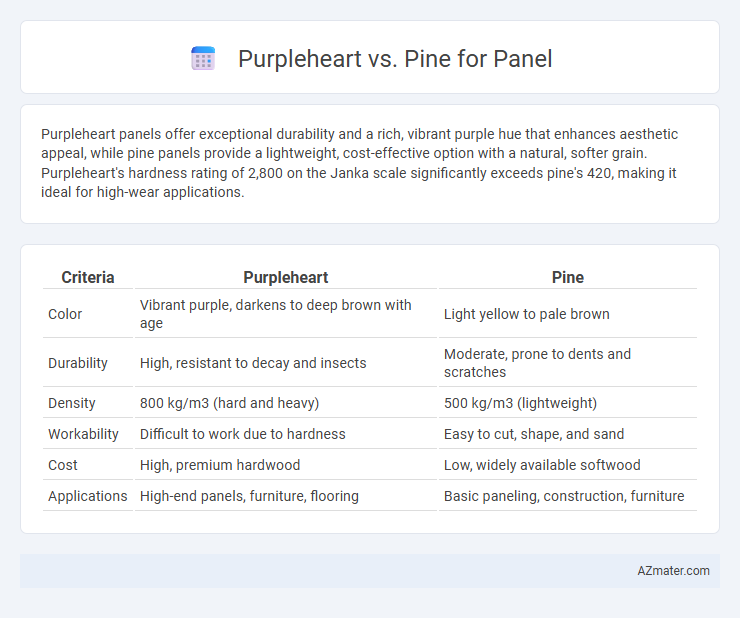Purpleheart panels offer exceptional durability and a rich, vibrant purple hue that enhances aesthetic appeal, while pine panels provide a lightweight, cost-effective option with a natural, softer grain. Purpleheart's hardness rating of 2,800 on the Janka scale significantly exceeds pine's 420, making it ideal for high-wear applications.
Table of Comparison
| Criteria | Purpleheart | Pine |
|---|---|---|
| Color | Vibrant purple, darkens to deep brown with age | Light yellow to pale brown |
| Durability | High, resistant to decay and insects | Moderate, prone to dents and scratches |
| Density | 800 kg/m3 (hard and heavy) | 500 kg/m3 (lightweight) |
| Workability | Difficult to work due to hardness | Easy to cut, shape, and sand |
| Cost | High, premium hardwood | Low, widely available softwood |
| Applications | High-end panels, furniture, flooring | Basic paneling, construction, furniture |
Introduction to Purpleheart and Pine for Panels
Purpleheart wood, known for its vibrant purple hue and exceptional durability, is highly prized for decorative panels requiring both aesthetics and strength. Pine, a softwood with a light color and uniform grain, offers affordability and ease of workability, making it a popular choice for versatile paneling applications. When selecting wood panels, considering the distinct hardness, color retention, and resistance to wear of Purpleheart versus the economical and readily available nature of Pine is crucial.
Key Characteristics of Purpleheart Wood
Purpleheart wood, known for its striking deep purple hue, offers exceptional durability and resistance to wear, making it ideal for high-traffic panels. Its dense, fine-grained texture provides a smooth finish that enhances aesthetic appeal and structural integrity compared to softer pine wood. Unlike pine, which is prone to dents and scratches, Purpleheart's hardness and natural oils contribute to its longevity and resistance to moisture and decay.
Unique Properties of Pine Wood
Pine wood is prized for its lightweight and soft texture, making it highly workable for panels and easy to shape or cut. Its natural resin content provides moderate resistance to decay and insects, while the pale color and distinct grain patterns offer aesthetic versatility in interior applications. Pine's affordability and availability also make it a cost-effective choice compared to denser hardwoods like Purpleheart, without compromising structural integrity in many paneling projects.
Appearance: Color, Grain, and Texture Comparison
Purpleheart wood features a striking deep purple to reddish-purple hue that intensifies with exposure to light, creating a bold and unique appearance for panels. Pine offers a lighter, more neutral color palette ranging from pale yellow to light brown, with a more uniform and pronounced grain pattern that contributes to a rustic or traditional look. The texture of Purpleheart is generally fine and smooth with a subtle natural luster, while Pine has a softer texture with visible knots and a more pronounced, coarse grain, enhancing its natural character.
Durability and Strength: Purpleheart vs Pine
Purpleheart wood exhibits exceptional durability and strength, with a Janka hardness rating of approximately 2,520, making it highly resistant to wear and impact. In contrast, Pine, particularly Southern Yellow Pine, has a Janka hardness around 690, rendering it much softer and more prone to dents and scratches. Purpleheart's dense, hard nature makes it an ideal choice for high-stress panels, while Pine suits applications where cost and ease of workability outweigh maximum durability requirements.
Workability and Ease of Use
Purpleheart is denser and harder than pine, which makes it more challenging to cut and shape but results in a durable, smooth finish ideal for high-quality panels. Pine is softer and more pliable, offering easier workability and faster cutting, making it suitable for quick projects or beginners. The choice between Purpleheart and Pine depends on the balance between desired durability and ease of machining in panel applications.
Cost and Availability Analysis
Purpleheart panels, known for their rich color and durability, typically command higher prices due to limited sourcing and slower growth rates compared to pine. Pine is widely available, making it a cost-effective option for large-scale projects and budget-conscious buyers, with prices significantly lower than Purpleheart's premium lumber. Availability fluctuations for Purpleheart, largely dependent on tropical rainforest conditions and export regulations, can cause price volatility, whereas pine benefits from sustainable plantation cultivation ensuring consistent supply and stable costs.
Environmental Impact and Sustainability
Purpleheart wood is highly durable and long-lasting, reducing the need for frequent replacement and thus lowering environmental impact over time, while its slow growth rate raises concerns about sustainable sourcing. Pine, a fast-growing softwood, is widely available and more easily renewable, making it a more sustainable choice when harvested from responsibly managed forests. Both woods require certification like FSC to ensure environmental sustainability and minimize deforestation effects during panel production.
Best Applications for Each Wood Type
Purpleheart wood excels in applications requiring high durability and resistance to wear, making it ideal for heavy-use panels, flooring, and furniture in both residential and commercial settings. Pine is best suited for decorative panels, interior wall cladding, and lightweight furniture due to its softness, ease of staining, and affordability. Both woods offer unique aesthetics: Purpleheart's vibrant purple hue enhances modern designs, while Pine's warm tones complement rustic and traditional interiors.
Conclusion: Choosing Between Purpleheart and Pine for Panels
Purpleheart offers exceptional durability, vibrant color, and natural resistance to decay, making it ideal for high-end, long-lasting panels. Pine, being more affordable and easy to work with, suits budget-friendly and lightweight panel projects where appearance and longevity are less critical. Selecting between Purpleheart and Pine depends on prioritizing either durability and aesthetics or cost-efficiency and ease of use for your specific panel needs.

Infographic: Purpleheart vs Pine for Panel
 azmater.com
azmater.com